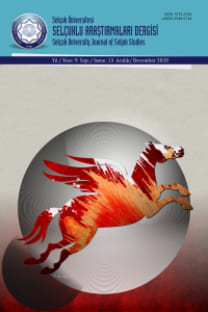AKSARAY’DA FAZLA TANINMAYAN ANADOLU SELÇUKLU TÜRBELERİ
Aksaray, Anadolu Selçuklu, Topakkaya Beldesi, Anonim Türbe, Çaput Baba Türbesi, Saliha Hatun Türbesi, Hasas Baba Türbesi
OBSCURE TOMBS OF ANATOLIAN SELJUKS IN AKSARAY
Aksaray, Anatolian Seljukides, Town of Topakkaya, Anonymous Tomb, Tomb of Saliha Khatun, Tomb of Çaput Baba, Tomb of Hasas Baba,
___
- Arık Olış, “Erken Devir Anadolu-Türk Mimarisinde Türbe Biçimleri”, Anadolu (Anatolia), 11, Ankara, 1967, s.57-100.
- Cantay Tanju, “Niksar Kırk Kızlar Türbesi”, Sanat Tarihi Yıllığı IX.-X., İstanbul, 1981, s.83-105.
- Evliya Çelebi, Seyahatname, (Çev.: Zuhuri Danışman), V, İstanbul, 1970.
- Deniz Bekir, Aksaray ve Çevresindeki Türk Devri Yapıları Rehberi, (Ankara Üniv., D.T.C.F., Yayınlanmamış Yüksek Lisans Tezi), Ankara, 1976.
- Erdal Zekai, Aksaray’daki Türk Devri Mimarisi, (Yüzüncü Yıl Üniv., Sos. Bil. Ens., Yayınlanmamış Doktora Tezi), Van, 2014.
- Konyalı İbrahim Hakkı, Abideleri ve Kitabeleri ile Niğde Aksaray Tarihi, II, İstanbul, 1974.
- Öney Gönül, Anadolu Selçuklu Mimari Süslemesi ve El Sanatları, Ankara, 1992
- Tuncer O. Cezmi, Anadolu Kümbetler 1, Selçuklu Dönemi, Ankara, 1986. __________, Anadolu Kümbetleri, 2, Ankara, 1991.
- İbrahim Hakkı Konyalı Kütüphanesi Arşivi.
- http://kuran.diyanet.gov.tr
- ISSN: 1015-2105
- Yayın Aralığı: Yılda 2 Sayı
- Başlangıç: 1986
- Yayıncı: Selçuk Üniversitesi
NİZAMÜ’L-MÜLK SUİKASTININ DÖNEMİN KAYNAKLARINA YANSIMASI
NİZÂMÜLMÜLK’ÜN DİNÎ VE FİKRÎ HAYATI
NİZÂMÜLMÜLK VE SELÇUKLU IKTÂ’ININ ŞEKİLLENMESİNDEKİ ROLÜ
NİZÂMÜLMÜLK’ÜN BÜYÜK SELÇUKLU İMPARATORLUĞU’NA HİZMETLERİ
BÜYÜK SELÇUKLU DEVLETİ VEZİRİ VE TÜRK TARİHİNİN ÖNEMLİ DEVLET ADAMLARINDAN NİZÂMÜ’L-MÜLK (1018-1092)
İBRAHİM KAFESOĞLU İLE OSMAN TURAN’IN KALEM KAVGASI VE ALANA YANSIMALARI
NİZÂMİYE MEDRESELERİNİN KURULUŞU VE ÖNEMİ
ALAİYE’DE MAARİF OTELİNİN İNŞASI VE TARİHİ SEYRİ (1912-1943)
